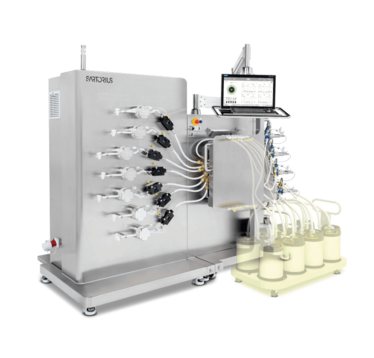
In with the New: Embracing Multicolumn Chromatography
Biopharma companies are rapidly making changes to their manufacturing strategies – and flexible downstream unit operation solutions that enhance process efficiency and reduce costs have a significant role to play
Casey Mihal |
sponsored by Sartorius

Every manufacturer asks themselves the same question: how can we cut costs? In biopharma manufacturing, developers are always seeking to reduce the cost per gram of products, and by extension this also addresses one of the industry’s most pressing issues – access to affordable medicine. If the cost of manufacturing operations could be reduced, it would influence the price of commercial drug products and allow more patients to benefit. However, for the industry to achieve its cost-cutting goals and more closely cater to patient demand, it must move away from traditional processes that come with low flexibility, high capital expenditure, and poor productivity.
Companies are already leaving conventional manufacturing practices behind and prioritizing the intensifying their downstream processes with next-generation technologies that can more effectively and efficiently manufacture the medicines of the future. These strategies are designed for intensified processing, with a focus on higher titers, smaller batches, and accelerated manufacturing. In the small molecule sector, there has been a huge uptake of continuous manufacture, which has led to a reduction in capital expenditure and the cost of drugs.
Having seen the benefits, drug developers want the same for biologics. When transitioning to an intensified process, it is essential to select the right hardware for the important manufacturing step of capture chromatography. This process provides the primary purification of a target molecule from a mixture – and it is also where a significant proportion of downstream processing costs are sunk. Traditionally, companies have relied on batch capture chromatography – an approach that employs a single column typically filled with costly affinity resins. This method pales in comparison to multicolumn chromatography (MCC), an approach that uses the benefits of parallel processing of smaller columns to greatly increase processing efficiencies. In fact, the use of MCC allows for a five-fold increase in productivity, which can be used to achieve up to 80 percent in cost saving on chromatography resin (1).
The superior bioprocessing power of MCC should be attractive to those manufacturers who are keen to transition towards newer, more efficient approaches. Let’s look at the advantages in more detail.

Breaking down bottlenecks
Historically, manufacturers have had to strike a balance between operation cost and time due to the limitations of batch capture equipment. A company can use a larger chromatography column to boost processing speed or use a smaller chromatography column with more cycles to reduce operational costs. Traditionally, it is the norm to use large columns, which require larger capital and larger operational investments – not only in terms of the bigger columns themselves but also the huge volumes of chromatography resins required.
Higher upstream titers should be beneficial to businesses; however, increasing titers have put huge strains on the batch capture step, which has become a significant bottleneck. To remedy the issue, those companies still relying on batch capture have been forced to either use increasingly large columns to maintain process times or, to keep costs sustainable, use the same size columns and tolerate a slower process. Some companies have turned to mid-sized columns in an attempt to achieve a happy medium between process time and cost. Such hardware typically runs between three and four cycles but these mid-sized columns struggle to keep up as titers increase; more cycles are needed, which results in companies frequently exceeding their allowable operation times. Moreover, finding the right balance between speed and cost is sometimes subject to other factors; for example, if a product is relatively unstable in the clarified matrix, the capture process must be completed quickly to avoid product degradation.
MCC has emerged as a powerful solution to overcome manufacturing bottlenecks, and it has the added benefit of doing this within a small footprint. The technology enables customers to process higher titers without increasing the process time or the consumables cost. MCC leverages two simple concepts. Unlike batch chromatography, it makes full use of the capacity of its columns through controlled overloading – a process that allows the breakthrough of one column to flow onto another, rather than down the drain. It also eliminates idle volumes in packed beds by dividing a larger column into smaller sections that can be processed quickly and independently. As a result, up to 80 percent less resin is used (2). By improving resin capacity utilization, higher titers can be processed without affecting set manufacturing times while still significantly reducing resin costs. Notably, reduced resin usage is also a significant advantage in clinical development, where expensive affinity chromatography resins are purchased for very specific projects and not used to expiry. If a molecule fails or the batch sizes are small, the significant capital spent on the partially used resin is lost.
Changing the narrative
From a regulatory standpoint, many agencies are encouraging companies to explore process intensification options like MCC, and this helps to break down barriers for the implementation of the technology. The wide range of tools and modeling capabilities available today also means that the transition from batch to MCC is an easy process with relatively low development costs.
However, there are some perceived barriers to use that have made some customers hesitant to adopt the technology. For example, companies have expressed concern that MCC could make the cleaning validation process more complex. However, MCC is designed to overcome such challenges! Technologies, such as BioSMB, offer a gamma-sterile, single-use flowpath to eliminate the need for system cleaning and cleaning validation. There have also been concerns about the feasibility of scale up and the limitations of the equipment. MCC system platforms span process development to compliant GMP operations and the BioSMB, in particular, is very flexible as the modularity and 8 column positions mean that it can be adapted for most process demands, including batch and continuous manufacturing.
Finally, with any new technology there are always questions about how easy it is to use and how long it will take to train staff to use it correctly. Some customers have worried that the system may be complicated, but the software (Phase Editor) is designed to make recipe writing intuitive and quick, so it doesn’t require specialized expertise to use. Ultimately, technology like this is designed to address the current challenges that arise in bioprocessing and help manufacturers make the switch to embrace next-generation processes. Manufacturers have already recognized the benefits of single-use systems when it comes to reducing operational time and costs, so the adoption of a single-use MCC solution should be a low-impact process for many customers.
MCC helps manufacturers work towards their goals of developing the facility of the future, and can accelerate processes and allow medicines to reach patients faster. I believe MCC is an emerging paradigm shift in downstream processing that will become a staple in next-generation facilities within the next several years because it provides a great entry point for the wider adoption of process intensification. As the industry moves towards next-generation facilities, it will be crucial that they put in place the right technologies that can truly transform bioprocessing. The capacity of MCC to enhance productivity and improve resin use means that we can help our customers to make new and existing products more accessible – a goal that helps create a healthier future for us all.
Casey Mihal is a Chromatography Application Specialist at Sartorius
- Sartorius, “Continuous Chromatography Multi-Column Chromatography Solutions for Minimizing Costs” (2021). Available at https://bit.ly/3tMScnD.
- Sartorius, “Why Multi-column Chromatography (MCC)?” (2021).



















